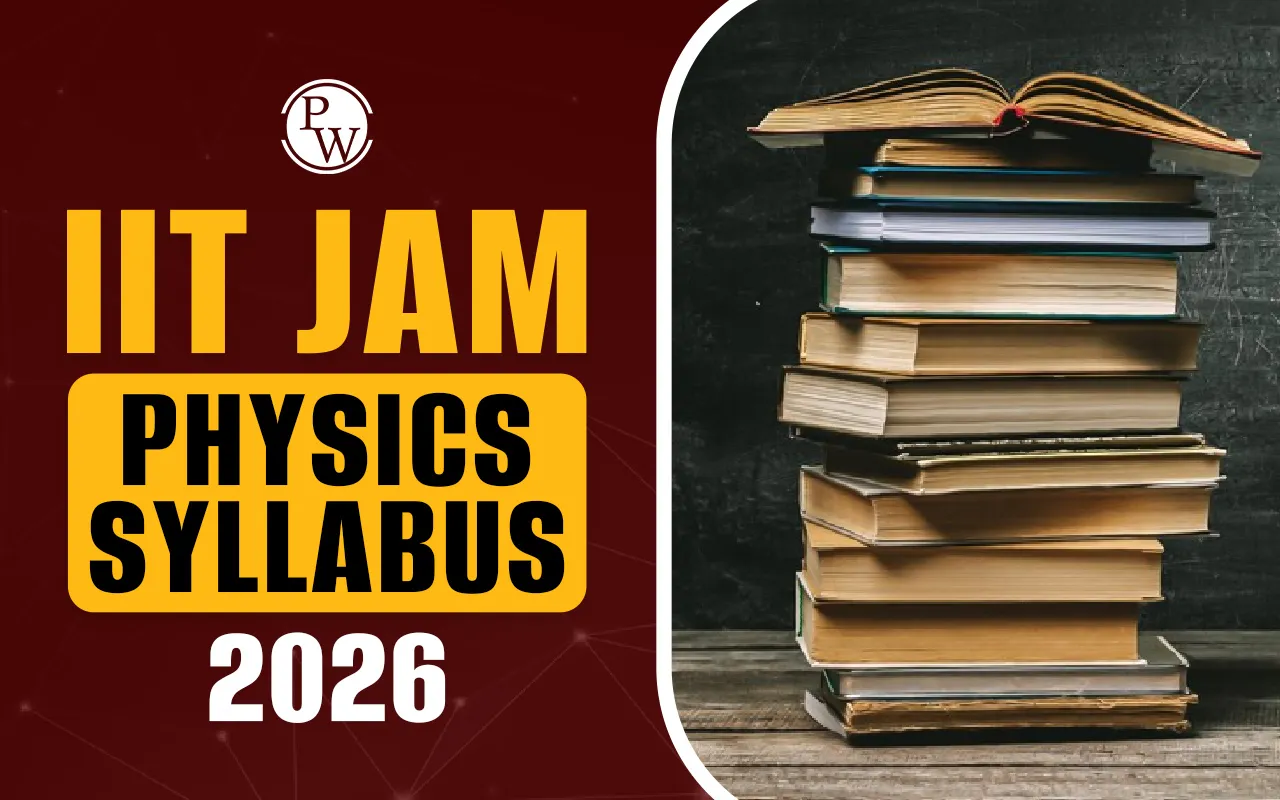
IIT JAM Physics Syllabus 2026 will be released by the authorities soon on the official website at jam.iitm.ac.in. Till then, candidates can refer to the IIT JAM Physics Syllabus 2025 to begin their preparation. The syllabus includes topics like Mathematical Methods, Mechanics, Oscillations, Thermodynamics, Modern Physics, Electricity and Magnetism, and more. Understanding the complete syllabus helps in better planning and focused study. Aspirants are advised to follow the syllabus carefully and start preparing early to cover all the important topics before the IIT JAM 2026 exam. Once the IIT JAM Physics Syllabus 2026 is released, we will update it here.
IIT JAM Physics Syllabus 2026 will be released soon on the official website. Check the given below table for better understanding.
|
IIT JAM Physics Syllabus 2026 Overview |
|
|
Particulars |
Details |
|
Exam Name |
IIT JAM (Joint Admission Test for M.Sc.) |
|
Subject |
Physics |
|
Exam Mode |
Computer-Based Test (CBT) |
|
Medium of Exam |
English |
|
Type of Questions |
Multiple Choice Questions (MCQ), MSQ, NAT |
|
Total Marks |
100 Marks |
|
Total Duration |
3 Hours |
|
Syllabus Includes |
Mathematical Methods, Mechanics, Thermodynamics, Oscillations, Modern Physics, Electricity & Magnetism, etc. |
IIT JAM Physics Syllabus PDF for 2026 will be released soon by the authorities on the official website. Until then, candidates can use the IIT JAM Physics Syllabus 2025 PDF to start their preparation. It has all the topics and subjects that are usually covered in the exam. Downloading the syllabus PDF helps in planning your studies in a better way. Make sure to keep checking the official website for the updated 2026 syllabus.
IIT JAM Physics Syllabus 2026 will be released soon on the official website. For now, candidates can start their preparation using the IIT JAM Physics Syllabus 2025 as a reference. Check the detailed subject-wise syllabus below:
|
IIT JAM Physics Syllabus 2026 |
|
|
Subjects |
Topics Covered |
|
Mathematical Methods |
Calculus of single and multiple variables, partial derivatives, Jacobian, imperfect and perfect differentials, Taylor expansion, Fourier series, Vector algebra, Vector Calculus, Multiple integrals, Divergence theorem, Green’s theorem, Stokes’ theorem, First-order and linear second-order differential equations, Matrices and determinants, Algebra of complex numbers |
|
Mechanics and General Properties of Matter |
Newton’s laws, motion in various coordinate systems, rotating frames, central forces, Kepler’s laws, gravitational field, conservative/non-conservative forces, system of particles, center of mass, conservation laws, elastic/inelastic collisions, rigid body motion, moments and products of inertia, principal axes, fluid kinematics, continuity equation, Euler’s equation, Bernoulli’s theorem |
|
Oscillations, Waves and Optics |
Simple harmonic motion, superposition, Lissajous figures, damped/forced oscillators, resonance, wave equation, standing/traveling waves, energy in waves, group and phase velocity, sound waves, Doppler Effect, Fermat’s Principle, image formation, lenses, interference, diffraction, Rayleigh criterion, polarization, double refraction, optical rotation |
|
Electricity and Magnetism |
Coulomb’s law, Gauss’s law, electric field and potential, Laplace’s equation, conductors, capacitors, dielectrics, polarization, electrostatic energy, Biot-Savart law, Ampere’s law, Faraday’s law, inductance, AC/DC circuits, Maxwell’s equations, electromagnetic waves, Poynting’s theorem, reflection/refraction at dielectric, Lorentz Force |
|
Kinetic Theory and Thermodynamics |
Kinetic theory of gases, velocity distribution, specific heat of gases, ideal and van-der-Waals gases, mean free path, laws of thermodynamics, isothermal and adiabatic processes, entropy, Carnot cycle, Maxwell relations, thermodynamic potentials, phase transitions, ensembles, Maxwell-Boltzmann, Fermi-Dirac, Bose-Einstein distributions |
|
Modern Physics |
Inertial frames, Galilean and Lorentz transformations, special relativity concepts, blackbody radiation, photoelectric and Compton effects, Bohr’s model, X-rays, wave-particle duality, uncertainty principle, Schrödinger equation and solutions, harmonic oscillator, quantum tunneling, Pauli principle, nuclear structure, radioactivity |
|
Solid State Physics, Devices and Electronics |
Crystal structures, Bravais lattices, Miller indices, X-ray diffraction, semiconductors, Fermi level, p-n junction diode, Zener diode, BJT characteristics, amplifiers, oscillators, OPAMPs and applications, binary number systems, Boolean algebra, logic gates, truth tables, de Morgan’s theorem |
IIT JAM Physics preparation needs proper planning and regular practice. Below are some easy tips to help you cover the syllabus step by step and prepare well for the exam:
1. Know the Full Syllabus First: Start by downloading and reading the latest syllabus of IIT JAM Physics 2026. Understand which topics are included under each subject like Mechanics, Modern Physics, Thermodynamics, etc. This will help you plan better.
2. Make a Simple Study Plan
Divide the syllabus into small parts and make a timetable. Give more time to tough topics and revise easy ones regularly. Try to follow the plan every day.
3. Focus on Important Topics: Some topics are asked more in the exam. Prepare these well as they carry good weightage.
Mathematical Methods
Oscillations and Waves
Modern Physics
Thermodynamics
4. Understand Concepts, Not Just Formulas: Try to understand the theory behind every formula. Learn how and where to use them. Solving numericals becomes easier when you understand the basics.
5. Solve Previous Year Papers: Practice last 5–10 years’ IIT JAM Physics question papers. This helps you understand the exam pattern and the level of questions.
6. Take Mock Tests Regularly: Start taking mock tests once you finish 60-70% syllabus. It will improve your speed, accuracy, and confidence.
7. Revise Again and Again: Keep revising your notes every week. Make formula sheets, concept maps, and short summaries for quick revision.
8. Clear Doubts Quickly: If you don’t understand something, ask a teacher or check video lectures online. Don’t keep your doubts pending.
